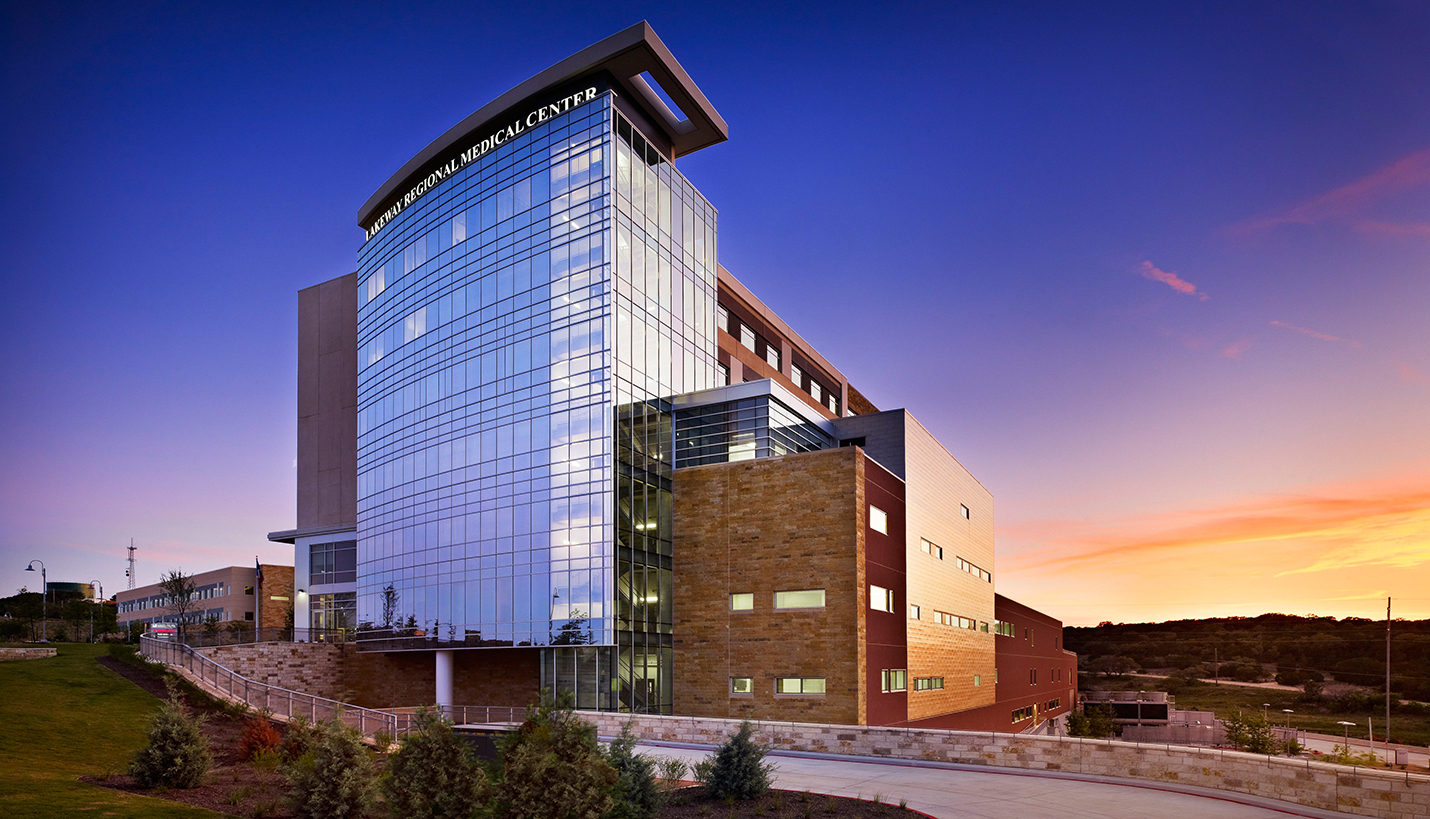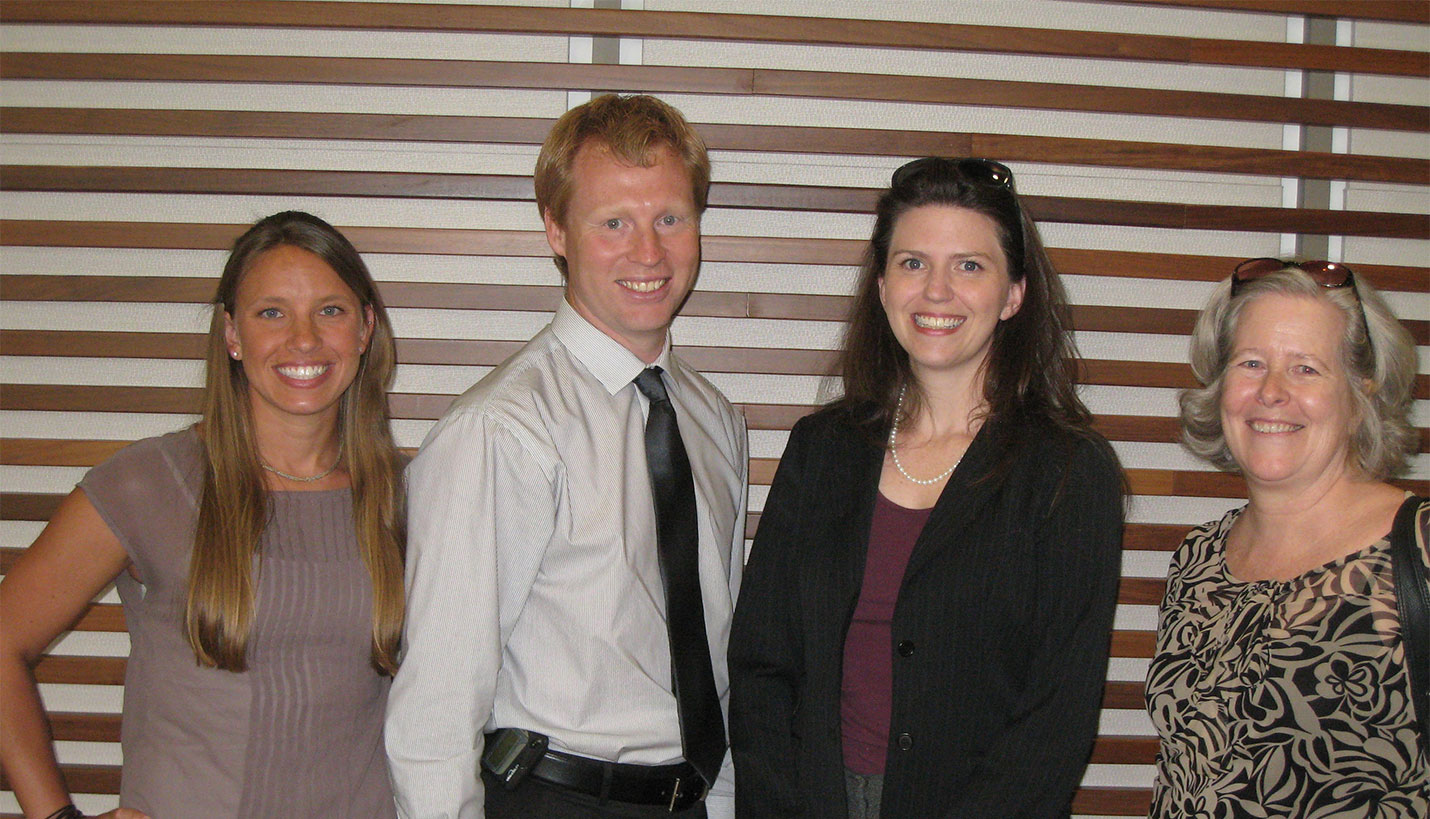




Lakeway Regional Medical Center Celebrates Dual Achievements in Sustainability
Lakeway Regional Medical Center (LRMC) took advantage of National Hospital Week to recognize its dual achievements of LEED Silver certification and a 3-star rating from Austin Energy Green Building (AEGB), as well as its two-year anniversary. Members of the Page design team, along with representatives of AEGB, participated in the celebration, which was held on May 15 at the hospital, located just outside of Austin.
Planning of this healthcare facility embodied both Lean and Evidence Based Design strategies, so the project naturally aligned with LEED and AEGB goals. Mandates to be cost effective and utilize sustainable design concepts, along with the surrounding Texas Hill Country landscape, impacted the final design solution for the 274,000-square-foot community hospital. The Page design team maximized the tight, steep site by creating a tall and relatively narrow building, with dramatic natural views and an abundance of natural daylight. This, combined with an onsite parking structure which mitigates urban heat island effect, retained a great amount of open space.
The building was designed to have a compact footprint while providing a high level of flexibility and planning for future expansion. Despite a relatively small site for the program, 57% of the site was restored using native and adapted landscaping, maintaining the important natural habitat and reducing water consumption associated with irrigation by an estimated 75%. Landscaping around the building helps control daylighting inside the hospital, and provides shaded gardens and water features that enhance the level of hospitality ambiance the client was seeking.
Extensive analysis was performed to achieve a highly efficient envelope to work in concert with mechanical systems to optimize the building’s energy savings. Numerous iterations of the design were investigated and analyzed, including shading locations, levels of insulation and percentage of glass. Shading devices were strategically placed to shade the southern face of the building during intense Texas summers. Reflective blue glazing on the building’s eastern curved face mirrors back views of the surrounding hill country while reducing internal heat load.
Page Principal Kregg Elsass, AIA, who presented the LEED Silver certificate to LRMC’s Interim CEO Joyce Grove Hein, said, “This LEED Silver certification identifies Lakeway as an exceptional example of sustainable design and demonstrates leadership in how to transform the building industry for the good. Achieving certification is even more challenging in a hospital, given the immense amount of energy a facility like this can consume.”
Inside the hospital, the health risks associated with indoor air quality were given the highest priority with close attention paid to controlling contaminants and volatile organic compounds (VOC) content in specified materials. The team selected low VOC paints, adhesives, sealants, and flooring systems and included contaminant source control through walk-off mats and high ventilation rates throughout the facility.
Energy efficient HVAC and lighting contributed to the building’s 23.7% energy savings, which were augmented by capturing waste heat to preheat hot water. The system design resulted in nearly 1 MW of avoided peak demand, contributing to a more reliable and cost-efficient electricity grid. Mechanical systems at Lakeway consist of three 600-ton VFD driven centrifugal water cooled chillers, coupled with two 350-ton VFD driven centrifugal water cooled energy recovery heat pump chillers. The combined system efficiencies greatly aided in the LEED Silver pursuit.
The design team also emphasized conservation through a whole building water system design that includes low consumption fixtures and equipment, while using stringent guidelines for considering both infection control and durability. Ultra-low-flow urinals, ultra-low flow water closets, low-flow lavatories and showers and selective sensor-operated fixtures reduce water use from non-process fixtures by 20%, saving over 400,000 gallons annually. A comprehensive storm water management system reduces and improves the quality of storm water runoff. The project has achieved a 90% reduction in potable landscape water use.
The Page team selected material with a total recycled content of 32.7% and sourced 57% of building materials from Texas. Eighty-two percent of the new wood used in the hospital was harvested in responsibly managed forests. The construction team worked diligently to exceed construction waste management goals of a 75% diversion rate, ultimately diverting 88% of construction waste (400 tons) away from landfills. They staged the construction site to optimize recycling potential while protecting and storing materials to bring the cleanest materials into the new hospital.
Debbie Kimberly, Austin Energy’s Vice President of Customer Energy Solutions, celebrated the hospital’s achievement by saying, “The Lakeway Regional Medical Center is an excellent example of a healing environment for patients, staff, and the community by using natural resources efficiently. This state-of-the art center will make a positive impact for generations to come. The 3-star AEGB rating demonstrates true leadership and commitment to a sustainable future.”
Page provided planning, Architecture, MEP and Civil engineering and LEED consulting for Lakeway, which was constructed by Hoar Construction. The hospital welcomed its first patients in April 2012.
05/20/2014
People
- Marsha Esponda Bernard
- Cory Boden
- Kregg Elsass
- Casey E. England
- Mika England
- Peter B. Hoffmann
- Jeffrey G. Jewesson
- Erin D. Nash
- Paul J. Stopper
- Brandon Townsend
- Randy C. Twedt
Related Posts
- Page-Designed Data Center Wins Global IT Award
- City on the Hill: Celebrating the Opening of Saint Francis Hospital TEC
- Media Coverage: Lakeway Regional Medical Center Dual Achievements in Sustainability
- Industry-leading Efficiency Data Center Achieves LEED Silver
- Cougar Woods Dining Hall Achieves LEED Silver Certification
- Best in brick: 7 stunning building façades made with brick
- University of Houston Debuts New Residential Dining Center








